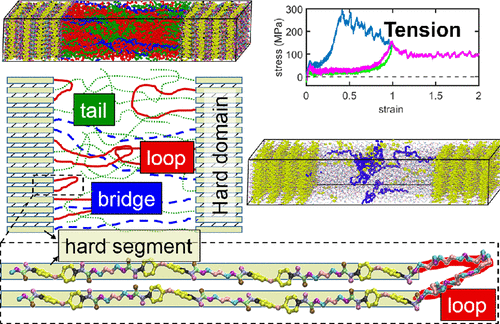当前位置:
X-MOL 学术
›
Macromolecules
›
论文详情
Our official English website, www.x-mol.net, welcomes your
feedback! (Note: you will need to create a separate account there.)
Molecular Simulation of Thermoplastic Polyurethanes under Large Tensile Deformation
Macromolecules ( IF 5.1 ) Pub Date : 2018-02-22 00:00:00 , DOI: 10.1021/acs.macromol.7b02367 Shuze Zhu 1 , Nikolaos Lempesis 1 , Pieter J. in ‘t Veld 2 , Gregory C. Rutledge 1
Macromolecules ( IF 5.1 ) Pub Date : 2018-02-22 00:00:00 , DOI: 10.1021/acs.macromol.7b02367 Shuze Zhu 1 , Nikolaos Lempesis 1 , Pieter J. in ‘t Veld 2 , Gregory C. Rutledge 1
Affiliation

|
Thermoplastic polyurethanes (TPUs) are useful materials for numerous applications due in part to their outstanding resilience and ability to dissipate energy under large mechanical deformation. However, the mechanistic understanding of the origins of these mechanical properties at the molecular level remains elusive, largely due to the complex, heterogeneous structure of these materials, which arises from the segregation of chemically distinct segments into hard and soft domains. In this work, molecular simulations are used to identify the mechanism of mechanical response under large tensile deformation of a common thermoplastic polyurethane comprising 4,4′-diphenylmethane diisocyanate and n-butanediol (hard segment) and poly(tetramethylene oxide) (soft segment), with atomic resolution. The simulation employs a lamellar stack model constructed using the Interphase Monte Carlo method established previously for semicrystalline polymers, which models the interfacial zone between hard and soft domains with thermodynamically rigorous distributions of bridges, loops, and tails. Molecular-level mechanisms responsible for yield, toughening, and the Mullins effect are reported. We have found several distinct mechanisms for yield and plastic flow, which we categorize as (i) cavitation, (ii) chain pull-out, (iii) localized melting with shear band formation, and (iv) block slip. The activity of these mechanisms depends on the topology of chains in the soft domain and the direction of loading (e.g., parallel or perpendicular to the interface). Further insights regarding toughening mechanisms and the Mullins effect are obtained from cyclic loading, where mechanisms ii to iv were found to be irreversible and account for the superior resilience and dissipation at large tensile strains in thermoplastic polyurethanes.
中文翻译:

大拉伸变形下热塑性聚氨酯的分子模拟
热塑性聚氨酯(TPU)是多种应用的有用材料,部分原因是其出色的回弹力和在大的机械变形下能够消散能量的能力。但是,在分子水平上对这些机械性质的起源的机械理解仍然难以捉摸,这主要归因于这些材料的复杂,异质结构,这是由于化学上不同的链段分离成硬域和软域而引起的。在这项工作中,分子模拟被用来识别包含4,4'-二苯基甲烷二异氰酸酯和n的普通热塑性聚氨酯在大拉伸变形下的机械响应机制。-丁二醇(硬链段)和聚(四氢呋喃)(软链段),具有原子分辨率。该模拟采用层状堆叠模型,该模型使用先前为半结晶聚合物建立的相间蒙特卡洛方法构建,该模型使用桥,环和尾部的热力学严格分布来模拟硬域和软域之间的界面区域。报道了负责屈服,增韧和穆林斯效应的分子水平机理。我们发现了几种不同的屈服和塑性流动机制,我们将其归类为(i)空化,(ii)链拉出,(iii)形成剪切带的局部熔化和(iv)块滑移。这些机制的活动取决于软域中链的拓扑和加载方向(例如,平行于或垂直于界面)。
更新日期:2018-02-22
中文翻译:

大拉伸变形下热塑性聚氨酯的分子模拟
热塑性聚氨酯(TPU)是多种应用的有用材料,部分原因是其出色的回弹力和在大的机械变形下能够消散能量的能力。但是,在分子水平上对这些机械性质的起源的机械理解仍然难以捉摸,这主要归因于这些材料的复杂,异质结构,这是由于化学上不同的链段分离成硬域和软域而引起的。在这项工作中,分子模拟被用来识别包含4,4'-二苯基甲烷二异氰酸酯和n的普通热塑性聚氨酯在大拉伸变形下的机械响应机制。-丁二醇(硬链段)和聚(四氢呋喃)(软链段),具有原子分辨率。该模拟采用层状堆叠模型,该模型使用先前为半结晶聚合物建立的相间蒙特卡洛方法构建,该模型使用桥,环和尾部的热力学严格分布来模拟硬域和软域之间的界面区域。报道了负责屈服,增韧和穆林斯效应的分子水平机理。我们发现了几种不同的屈服和塑性流动机制,我们将其归类为(i)空化,(ii)链拉出,(iii)形成剪切带的局部熔化和(iv)块滑移。这些机制的活动取决于软域中链的拓扑和加载方向(例如,平行于或垂直于界面)。









































 京公网安备 11010802027423号
京公网安备 11010802027423号